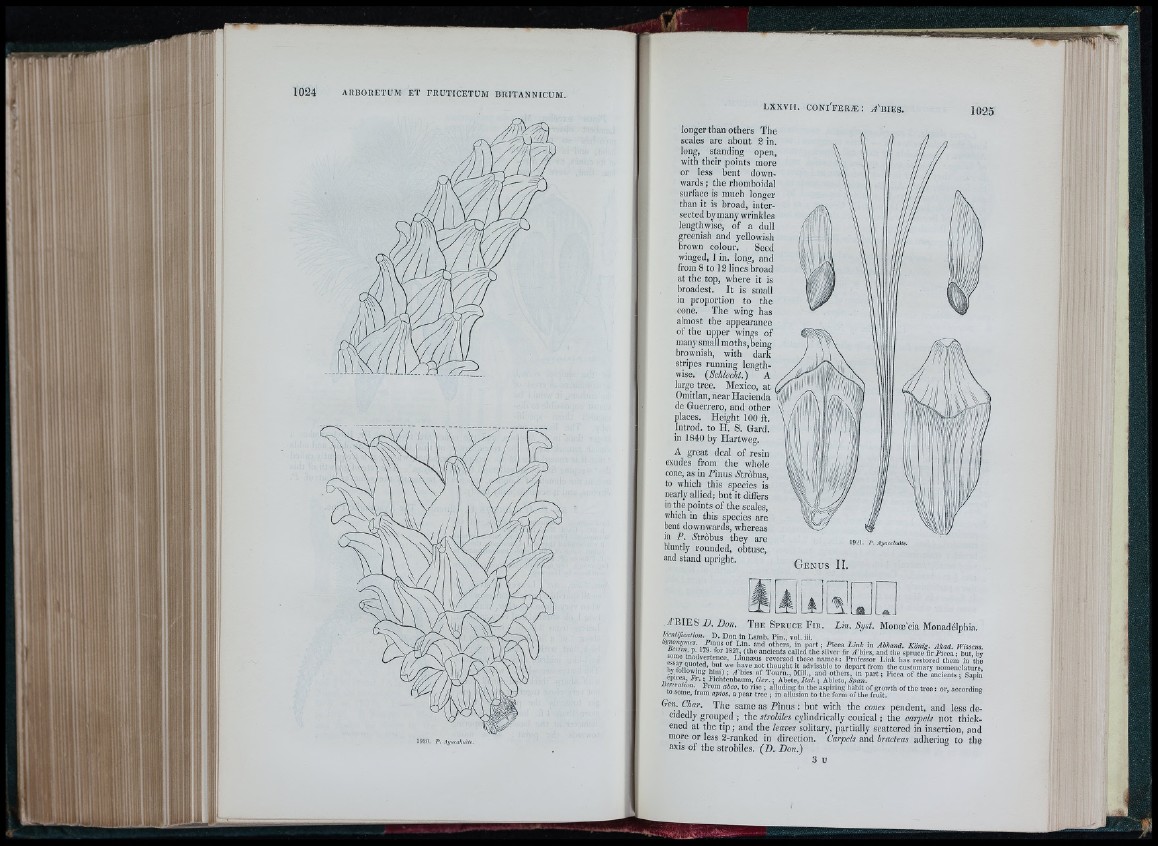
1 0 2 4 AR BO RE TUM E T FR U T IC E TUM B R ITA N N ICUM .
l'J'/O. p . AynchuHc.
s « s « s â ; ^
LX X V II. c o n i 'f e r æ : æ ' b i e s . 102 5
longer than others The
scales are about 2 in.
long, standing open,
with their points more
or less bent downwards
; the rhomboidal
surface is much longer
than it is broad, intersected
by many wrinkles
lengthwise, of a dull
greenish and yellowi.sh
brown colour. Seed
winged, ] in. long, and
from 8 to 1 2 lines broad
at the top, where it is
broadest. It is small
in proportion to the
cone. The wing has
almost the appearance
of the ujjper wings of
many small moths, being
brownish, with dark
stripes running lengthwise.
(Schlecht.) A
large tree. Mexico, at
Omitían, near Hacienda
de Guerrero, and other
places. Height 1 0 0 ft.
Introd. to H. S. Gard.
in 1840 by Hartweg.
A great deal of resin
exudes from the whole
cone, as in Pinus «tròbus,
to which this .species is
nearly allied; but it differs
in the points of the scales,
which in this species are
bent downwards, whereas
in P. «tròbus they are
bluntly rounded, obtuse,
and stand upright.
1971. P . Ayacahuite.
G en u s I I .
.._ - â k . _
te BIES D. Don. T h e S p r u c e F i r . Lin. Sy.st. Monoe'cia Monadélphia,
identification. D. Don in Lamb. P in ., vol. iii.
P íc e a Zm/f in Abhand. König. Akad. Wissens.
i im ï ancients called the silver fir ^ 'b ic s, and the spruce fir Pícea ; but, by
t e . ^ ‘»níEus reversed these name s: Professor Link has restored them in the
bv follo S ’v “ ft'''®teta''® thought it advisable to depart from the customary nomenclature,
S iS a 1 ^‘®® Tourn., Mill., and others, in part ; Picea of the ancients ; Sapin
tpicea, Fr. ; Fichtenbaum, Ger. ; Abete, Ital. ; Abieto, Span. ’ ‘
tS ” ^® ’ anodine: to the aspiring habit of growth of the tree : or, according
to some, from apjos, a pear tree ; in allusion to the form of tlie fruit.
Gen Char. The same as Pinus ; but with the cones pendent, and less decidedly
grouped ; the cylindrically conical ; the carpels not thickened
at the tip; and the leaves solitary, partially scattered in insertion, and
more or less 2-ranked in direction. Carpels and bracteas adhering to thè
axis of the strobiles. {D. Don.)